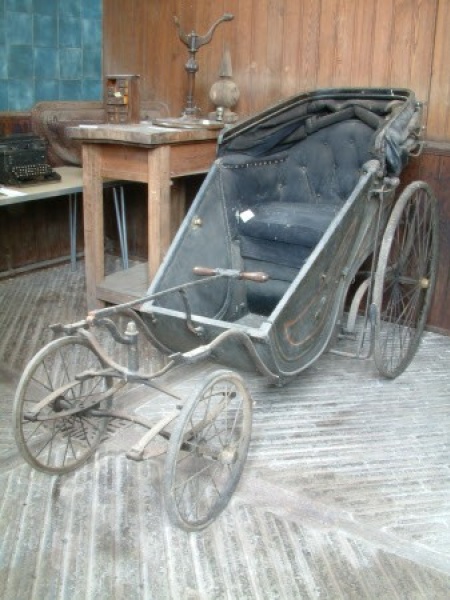Listed in 1 collection
Listed at 1 museum
Listed for 1 maker
Quick Details
Carriage Type
Invalid Carriage
Date of Production
mid 19th century
Accession or Inventory Number
NT 40002.1
Materials used
Paint, Wood, Iron, Leather, Wool Box ClothSummary of Invalid Carriage
An invalid Carriage built during the first half of the nineteenth century, the builders name is engraved on the axle caps but it is illegible. Intended to be pulled by a single pony or donkey or propelled by an attendant. The body is sprung on elliptic and C springs and has a curved profile. There are doors on both sides that can be easily removed. The hood is made of leather. At the front is a tiller for steering with wooden handgrips. At the back is a push handle of turned wood attached with metal brackets. Upholstered in dark blue wool cloth. Painted in black with gold and red lining, on the back panel 'H. Gardner' is painted.
This is an elegant invalid carriage which could have been used in a variety of forms. The doors could be removed for a more elegant profile and there are attachments for a leather apron.
Dimensions
Height: 5ft 9"
Length: 6ft 11"
Width: 3ft 8"
Full description
This Invalid Carriage has a round-backed cut-under body with an elegant curvilinear profile when the doors are removed. The two hinged side doors, which can be lifted off, give the vehicle a heavier and less attractive profile. Hinges on the front of the footboard show that a framed apron (now missing) was also originally fitted. There is a stay to support it in the open position. A turned wood pushing handle on metal brackets is fitted at the back. The leather head, on two pairs of curved joints, can be easily removed by unscrewing two wing-headed screws and pulling it back to release two tongues from two staples at the front.
The carriage has bicycle type wire wheels on grease axles with grease caps in the centre of the hubs and it is sprung on elliptic springs in front and side and C springs behind. All of the fore carriage is of iron and of minimal construction, with curved stays supporting the body. A square on the top of the bolt on the fore carriage carries the T handle which can be used to pull the carriage, or as a steering tiller. It is probable that there was originally a pair of shafts that could be fitted instead of the T handle, so that the carriage could be pulled by a pony. This carriage has a rolling bar brake with hand lever on the near side, the ratchet plate is attached to the side of the body.
The body, wheels and undercarriage of this Invalid Carriage are painted black with the panels edged with a fine gold line, and they have heavy gold lines set in from the edges to create the effect of frames and panels. The heavy gold lines are edged with fine red and bordered with fine gold lines. “H. Gardner (2)” is written in gold on the back panel. The cushion, seat fall, and linings except for the door linings are upholstered in dark blue wool cloth and the door linings in black leather-cloth.
Inscriptions
The builder’s name is engraved on the axle caps, but it is illegible.
Condition report
All of the structure appears to be in sound order with only very minor local damage. The knob is missing from the nearside door, and the mechanism is very slack on the offside door. The paint on the body is in good condition with losses only in way of minor local damage. There is considerable rusting of the ironwork, with associated paint loss. On opening the leather head the upper pair of joints could be fully opened if the head is inspected and it is found that the leather will not be damaged by doing so. However, it may possibly need to be cleaned and lubricated first. It is in good condition. There is much moth damage to the interior linings, and evidence of active moth and possibly other insects attacking the cloth, particularly the head lining.
Access information
This Invalid Chair is in the care of the National Trust at Tyntesfield House.
Wraxall,
Bristol,
North Somerset,
BS48 1NX
Picture credit
The National Trust

 Carriage Foundation
Carriage Foundation